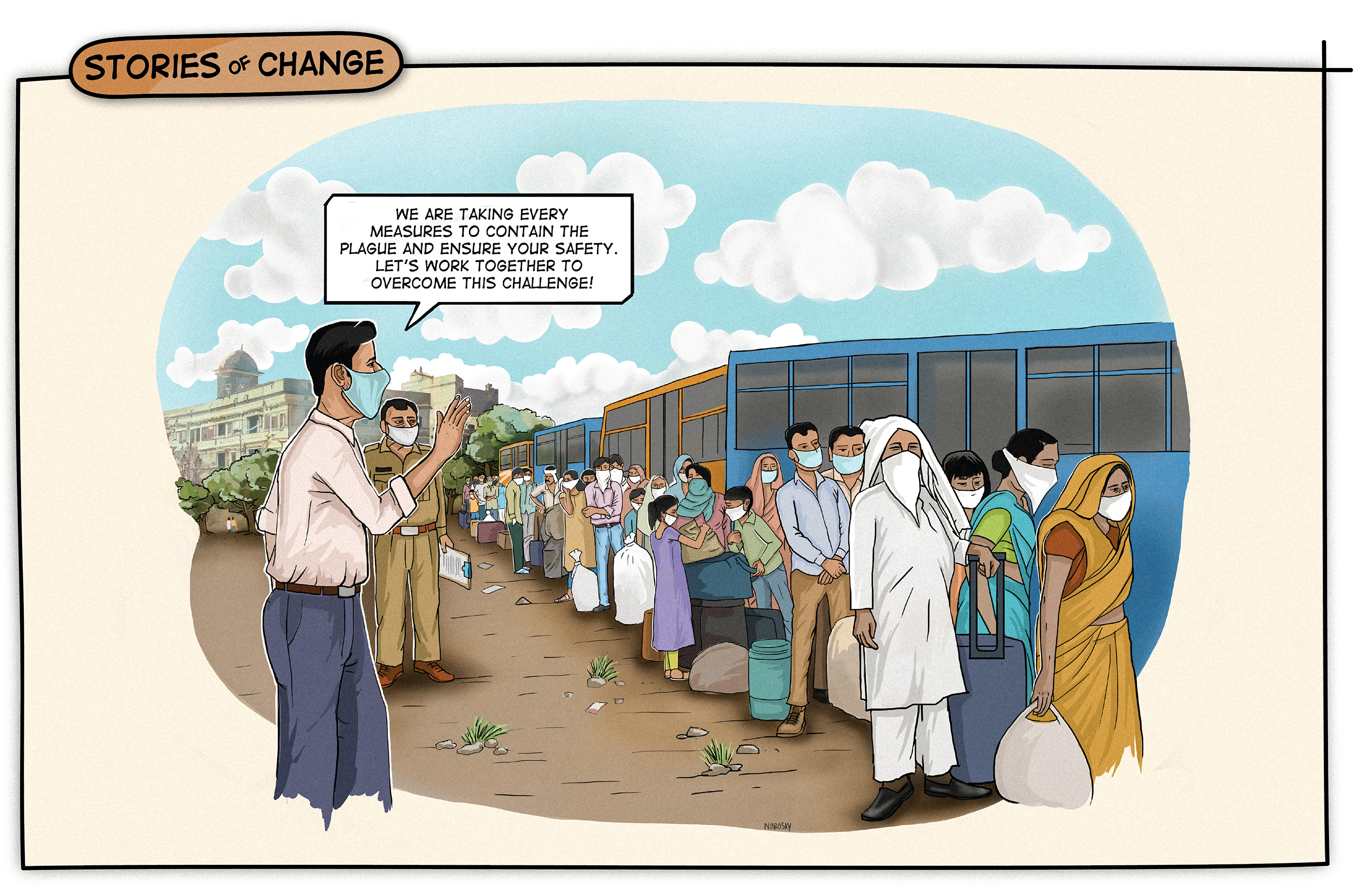Guardians of Surat: Public Officials in the Face of the Plague
Capacity building can be defined as the process of equipping public officials, stakeholders, communities to continuously develop and strengthen their attitudes, skills and knowledge for effective and efficient public service delivery.
Over the years, there have been some transformational interventions in the capacity-building ecosystem in India that have improved the state of public service delivery and enhanced the quality of citizen-centric governance.
This five-part blog series titled ‘Stories of Change’ delves into some of the successful yet seldom celebrated interventions by public officials that were instrumental in improving the execution capacity of our government.
The Surat Plague of 1994 serves as a haunting testament to the catastrophic consequences that can arise from a public health emergency. This deadly outbreak of the bubonic plague, a highly contagious bacterial infection spread by fleas that live on rats, struck Surat, a vibrant metropolis in the Indian state of Gujarat, plunging the city and its inhabitants into a state of terror and apprehension. The city, known for its thriving textile industry and a population of over two million, was ill-prepared for such a health crisis. Panic and misinformation spread rapidly, resulting in mass exodus and economic distress.
In the face of this dire situation, it was the public officials of Surat who shouldered the weighty responsibility of curbing the crisis and averting further calamity.
The Role of Public Officials
Early Detection and Communication
The first crucial step in managing any public health crisis is early detection and rapid communication. In the case of the Surat Plague, public officials initially failed to promptly identify and communicate the severity of the outbreak, leading to rumours and panic among the population. However, as the situation worsened, public officials realised the importance of early detection and communication. They swiftly established a surveillance system to identify and report new cases promptly.
Mobilising Resources
Public officials, including officials from local government bodies and health departments, did all they could to mobilise resources to combat the plague. They set up quarantine facilities, established control rooms, and coordinated with healthcare workers to provide medical aid to affected individuals. These efforts were essential in isolating infected individuals and preventing further transmission.
Implementing Containment Measures
To curb the spread of the disease, public officials initiated strict containment measures. Quarantine zones were established, and surveillance was intensified to identify potential cases. Large-scale disinfection programs were undertaken to eliminate rats and fleas, which were carriers of the infection. The enforcement of these measures required coordination between multiple agencies and public cooperation.
Public Awareness and Education
Public officials recognized the importance of disseminating accurate information to dispel rumours and alleviate fear. They launched extensive public awareness campaigns through various channels, such as radio, television, and community outreach programs, to disseminate accurate information about the outbreak, its severity, and preventive measures to mitigate the spread. This played a significant role in building trust, encouraging compliance with control measures, and preventing the spread of panic.
International Collaboration
Given the severity of the outbreak, public officials sought assistance from international organisations and health experts. The World Health Organization (WHO) and other agencies provided technical guidance, resources, and expertise to combat the plague effectively. This collaboration showcased the importance of international cooperation in managing global health emergencies.
Cleaning up Surat
Cleaning up the city became a top priority during the plague outbreak. Concerted efforts that were made to restore hygiene and sanitation in the city lasted much longer after the outbreak subsided. In 1995, Suryadevara Ramachandra Rao was appointed as the Municipal Commissioner of Surat. He is known to have said - “Bureaucratically, it was a suicide posting. I had little option but to clean up the city on war footing.” Under his leadership, a comprehensive cleanup drive was launched -
- Mass Cleaning, Disinfection and Vector Control: Initiating large-scale cleaning and disinfection drives throughout Surat to eliminate potential breeding grounds for disease-carrying vectors like rats and fleas through eradication programs..
- Removal of Garbage and Waste: Implementing an extensive waste management system for prompt collection and disposal of garbage.
- Improved Sanitation Infrastructure: Focusing on repairing and maintaining sewage systems, ensuring proper drainage, and promoting sanitary practices.
- "AC to DC" Operation: Getting officers out of their offices to supervise sanitation workers on the streets.
- Public Awareness and Education: Initiating public awareness campaigns to educate the population about hygiene practices, waste management, and disease prevention.
- Demolishing Unauthorised Structures: Taking down illegal encroachments driven by wealthy residents.
- Compliance from Smaller Entities: Targeting the wealthy to achieve compliance from smaller businesses, residential societies, and religious institutions in removing encroachments.
- Tax Recovery and Financial Discipline: Directing officers to collect municipal taxes, improving tax collections, and funding infrastructure projects.
- Streamlining Construction Projects: Introducing strict timelines and reducing corruption by shortening the time lag between planning and execution.
- Improved Infrastructure: Finishing projects within months, covering open drains, establishing pay-and-use toilets, and imposing fines on littering.
- Accountability and Discipline: Weeding out corrupt elements, disciplinary action against non-performing employees, and addressing complaints promptly.
- Instituting a Grievance Redressal System: Implementing a complaint redressal system and fixing responsibilities and targets for grievance resolution.
These efforts, led by S. R. Rao, played a significant role in cleaning up Surat, so much so that two years later, the Indian National Trust for Architectural and Cultural Heritage (INTACH) declared Surat as the second cleanest city in India after Chandigarh.
Conclusion
The Surat Plague of 1994 remains a haunting chapter in the history of public health emergencies. While the outbreak caused immense suffering and economic losses, it also catalysed change. Public officials faced numerous challenges, but their actions in mitigating the crisis demonstrated the importance of leadership, collaboration, and the relentless pursuit of public welfare. The lessons learned from the Surat Plague continue to shape public health policies and preparedness, ensuring that future generations are better equipped to face similar challenges and protect the well-being of their communities.
Sources
- https://academic.oup.com/jid/article/197/Supplement_1/S34/842373
- ttps://www.thebetterindia.com/250052/surat-pneumonic-plague-1994-clean-city-india-ias-hero-sr-rao-inspiring-nor41/
- https://timesofindia.indiatimes.com/india/plague-hero-to-clean-up-surat/articleshow/1886380.cms
- https://timesofindia.indiatimes.com/india/plague-hero-to-clean-up-surat/articleshow/1886380.cms
- https://theprint.in/health/1994-surat-plague-has-many-lessons-for-india-on-how-to-beat-coronavirus/379531/
- https://citizenmatters.in/surat-the-countrys-second-best-managed-city-23345
- https://www.counterview.net/2014/02/known-for-impeccable-reputation-ias.html
- https://apps.who.int/iris/bitstream/handle/10665/205616/B3632.pdf?sequence=1



Add new comment